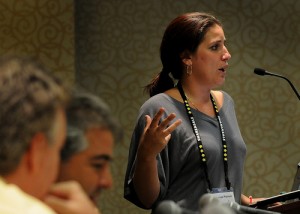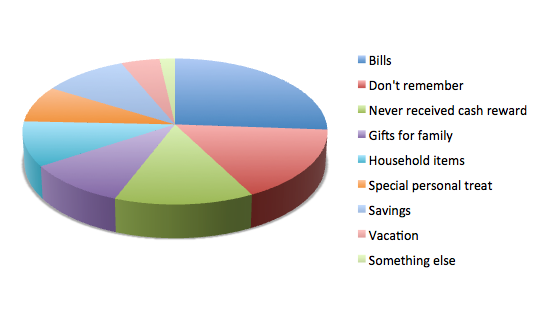It’s almost August, which means two very important things are just around the corner…
- Affiliate Summit East in New York City …
- The very busy Q4 and holiday shopping season.
With those two things in mind, ShareASale welcomes a special guest blogger Rae Hoffman-Dolan.
Rae Hoffman-Dolan aka “Sugarrae” is an affiliate marketing veteran and SEO consultant specializing in providing SEO audit services and link building strategies. She is also the SVP of Marketing for Speedy Online Incorporation. You can connect with Rae via Twitter or meet her in person at the Affiliate Summit East 2011 SEO Training designed specifically for merchants and affiliates (act quickly – seating is limited).
Enjoy!!!
…

The Importance of (Realistic) Affiliate Incentive Programs
A few years back one of the merchants we worked with got a new affiliate manager after years of lacking any decent support. In an effort to re-energize affiliates and show that he planned to be an active affiliate manager, he immediately created a bonus program for his first full month in his new position.
The problem was that he created his incentive using a “one size fits all” mentality. The “new incentive” email proudly told us that if we doubled sales during that month, we’d receive an extra 5% commission on all sales for the month. From an outside view, the offer sounded great. If I sold five of their products last month, all I needed to do was sell a total of ten this month to hit the bonus.
But we were one of their top affiliates generating a healthy six figures a year in sales for their program. Doubling our sales at the drop of a hat was not only unrealistic but it also made us feel punished for being a top producer. Additionally, this program didn’t offer any long term incentives to be a top producer – only short term and unattainable (for us) ones.
The result?
We put more promotional efforts into other programs that ran on the site – programs that rewarded us both long term and short term for being top producers. We didn’t even attempt to hit their “bonus” because we knew the numbers were unattainable.
Long term incentives
When you create an affiliate incentive program, it’s important that you set “long term” incentives in addition to short running ones. Long term is giving a standing reward (say a standing commission increase or a yearly all expenses paid getaway) to your top producers, providing they maintain a certain amount of volume (you’ll need to decide what that is) in sales each month for a certain period of time that you designate.
Short term incentives
A short term incentive is a limited time offer. For example: “Increase sales during the month of November by 20% and we’ll give you ________.” When you create short running incentive bonuses be sure to create separate bonus programs – one targeting your standard affiliates and one targeting your top producers. This will help avoid the potential alienation I described at the beginning of this post.
Be sure to create programs that are realistic to achieve with some additional effort. You may tell standard affiliates to increase sales by 50% to obtain the reward while only requiring your top performers to increase sales by 10%. Depending on the percentage of overall revenue your affiliate program brings in, you may even want to think about creating specific and unique offers for each of your top affiliates.
Cash rewards vs. tangible rewards
Incentives can be executed in one of two ways. The first option obviously is cash (usually by way of a commission increase). The second is to give your top producing affiliates a tangible reward (i.e. giving away iPads or a retreat for your top producers each year).
Me? I prefer cash – but studies show that you may get more bang for your buck with tangible rewards.
“A study conducted for the Goodyear Tire & Rubber Company demonstrated that while the performance of a group of participants rewarded with cash and another group rewarded with tangible incentives improved during the program, the increase shown by those receiving tangible rewards was nearly 50 percent more than those of the other group.” – Perks.com
Why? Likely because when given cash, folks tend to spend it responsibly. The respondents to the Goodyear Tire study spent their cash bonuses on:

29% of them spent the money on bills. 18% of them don’t even remember what they did with the money. Only 14% spent the bonus on something you could classify as “awesome” (9% spent it on personal treats and 5% spent it on vacation).
By giving folks tangible rewards, you ensure that they get something they (obviously, looking above) wouldn’t spend their money on otherwise – but would view as “awesome.”
“About 4 of 5 respondents (78%) perceive that travel is remembered longer than cash; about 4 of 5 (84%) agree that merchandise is remembered longer than cash. Nearly two-thirds of respondents (62%) feel that cash is remembered for the shortest time.” – 2005 Incentive Federation Survey
And offering non-cash rewards may improve the ROI for you as well:
“A study conducted by WorldatWork found that non-cash rewards achieved three times the return-on-investment than cash-based incentives.” – Chron
You can find out which type of incentive produces the best results either by running both types and comparing the results. Or you could simply ask your affiliates which type of program would get them most excited by including a link to a short survey in your next affiliate newsletter.
Incentive Importance
I promise you that if you’re not running – at the very least – a long term incentive program, you’re risking the loss of your top affiliates and/or the best promotional spaces on their sites to merchants that are. Considering the 80/20 standard in affiliate marketing (i.e. 80% of your sales come from 20% of your affiliates) it’s important that you make your strongest affiliates feel valued.
How accurate is the 80/20 rule? I asked a friend with a very successful Shareasale merchant program to share their percentages with me for this post. You may be surprised to find that:
- 46% of their sales are driven by the top 5% of their active affiliates
- 64% of their sales are driven by the top 16% of their active affiliates
- 73% of their sales are driven by the top 26% of their active affiliates
Your top performers are incredibly important to the overall success of your affiliate program. Remember to remind them that you appreciate them every so often.
Rae Hoffman-Dolan aka “Sugarrae” is an affiliate marketing veteran and SEO consultant specializing in providing SEO audit services and link building strategies. She is also the SVP of Marketing for Speedy Online Incorporation. You can connect with Rae via Twitter or meet her in person at the Affiliate Summit East 2011 SEO Training designed specifically for merchants and affiliates (act quickly – seating is limited).

 John Murphy says
John Murphy says
August 2, 2011 at 5:07 amThe 80/20 rule really does apply in the vast majority of situations and I am not surprised from the merchant program you quoted. It highlights the need to look after the top 20%, and while this may sound like elitism, it is in fact a business reality that cannot be ignored! Interesting article, thank you!
 Baby Freebies says
Baby Freebies says
August 18, 2011 at 1:41 pmTotally agree with you John.
 Amanda says
Amanda says
August 20, 2011 at 12:18 pmWe manage 5 different affiliate programs, and non cash incentives have always worked better.
 Rise says
Rise says
August 31, 2011 at 4:26 pmWell, I just got my first incentive (bonus) from one merchant I’m promoting and it feels great and it makes me wanna try even harder…so I guess incentives really do work :)
 Robert says
Robert says
September 12, 2011 at 6:25 amWith the proliferation of online content out there so deep now you have to make your website stand out. I’ve spent the past 2 years building content and trying to focus on the long term. One day the affiliate marketing may kick in to a decent level but in the meantime I keep developing the sites I run because I enjoy it. I’ve seen Sugarrae on some other SEO and Affiliate sites and her tips are very helpful. Not everyone is motivated by cash.
 Jason says
Jason says
September 27, 2011 at 11:17 pmIncentives are always a good way to get your affiliates pushing out promotions to increase sales. I’ve seen some networks that have merchants who will do this simply as a sales gimmick and never give the rewards as promised.. Needless to say I’ve never once had to worry about things like this with Share-a-Sale.
 Event Tickets Printing says
Event Tickets Printing says
September 30, 2011 at 11:22 pmNo doubt, incentive programs do work.
 George Davis says
George Davis says
October 11, 2011 at 8:44 amThanks for sharing i am glad to hear that more efficient to run queries over data that originally came from different sources.
PC Pro Schools
 George Davis says
George Davis says
October 12, 2011 at 2:38 pmAwful! Thank you for this extremely helpful substance. I’ve been hunting a solution to mark via email for a spell now and this retributory prefabricated everything devolve into space! Thanks again!
 Peter Potter says
Peter Potter says
May 30, 2013 at 1:25 pmI have been an affiliate for a number of years. I can not remember the ones that have given a cash bonus or incentive because that has gone in to the business accounts. However, I can tell you the ones that have sent me on holiday or given me physical items such as ipads, camera’s etc.
 Nathaneal Boggs says
Nathaneal Boggs says
April 11, 2017 at 9:54 amIt’s 2017 and I still find this article extremely relevant.
In my experience Incentives are the #1 way to get the affiliates to move alone. It is similar to holding candy in front of a child(or any other incentive).
One drawback I do find is that big incentives bring huge players in the affiliate marketing space. which increases competition and can increase an overlapping effect.